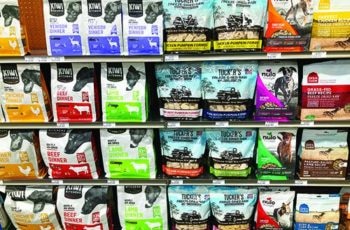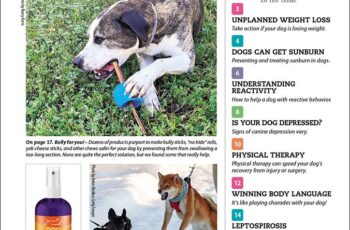A herding ball is a large, sturdy ball that is designed to be pushed around – not picked up – by a dog. Herding balls are not meant to be fetched, though there is a sport that rewards a dog’s ability to intentionally direct the ball toward you, or into a goal, on your cue. Dogs may use pressure against the ball with their noses, mouths, paws, and/or legs to send the balls rolling across a field at top speed, or by using their shoulders or hips to body the balls around turns, through gates, or into a soccer-net type of goal. The activity can be fantastic fun for athletic, energetic dogs.
However, you may not be able to accurately predict whether your dog will enjoy a herding ball; I couldn’t! It turns out that Woody, my fetch-obsessed Pit/Lab-mix, could not care less about balls that are too big to pick up and carry in his mouth.

In contrast, Boone, my fuzz-faced mutt who fetches only in order to run away with the fetch item, hoping that someone will chase him – that dog developed new life goals within a millisecond of coming in contact with a herding ball. (He aspires to set land-speed records for ball herding and ball-herding obstacle courses.)
What’s even more extreme than “obsessed”? That’s Boone and herding balls – and you know how it is when someone you love immerses himself completely in a new hobby? – you get some real enjoyment from indulging their newfound passion. I’ve been buying all sorts of herding balls for Boone to try out, and together we’ve developed some strong opinions about these toys.
Here’s what I’ve learned about herding balls over the past month of spoiling Boone with a wide variety of the toys:
How are herding balls made?
Herding balls are made with a variety of materials – and it’s likely that your dog will strongly prefer some materials to others. Some herding balls are made with hard, impervious plastics, in order to make it impossible for a dog to pick up the ball in his mouth (herding balls are meant to be pushed, not carried!). But even different types of hard plastics have a different feel – a slightly different hardness, if that makes sense. Out of two top-selling hard plastic herding balls, Boone has developed a passion for one ball and utter disdain for the other; go figure. You can guess what your dog might like most, but you’ll probably have to try a few to find out.

Hard plastic herding balls are not inflated; they are molded in a globe shape that cannot be compressed. They roll faster than balls made of other materials. They are highly resistant to damage from the dog’s teeth and claws (and crashing into brick walls and sidewalk edges), though the softer hard plastic can develop gouges and micro-ridges that are sharp enough to cut a dog’s nose, lips, or tongue as he pushes it at speed. I’ve occasionally had to use sandpaper to smooth the surface of Boone’s favorite.
Other herding balls are made with a thick, dense material that has a rubbery feel. Like the hard plastic balls, these balls are not inflated, but they can be grabbed, picked up, and compressed by a big dog with a strong jaw; fortunately, they pop back into a globe shape immediately upon being dropped.

These balls don’t roll as quickly as the harder balls, but neither do they develop the kind of scratches and gouges that the hard plastic balls do. If a big dog who aggressively chews toys was left alone with one of these balls, it could get chewed up.
The last type of ball is the only one used by dogs in herding-ball sports, though they are not made for this purpose. Rather, they are the kind of large, soft, inflatable balls that are used for human exercise and yoga. Some dogs enjoy pushing these bouncy, slightly yielding balls to the exclusion of all others – and some dogs can’t resist biting (and popping) them. I’m looking at you, Boone!
How big are herding balls?

Herding balls are made in a variety of sizes – and the size of the ball affects how safe it is for your dog to play with. In the sport of Treibball, where dogs push soft exercise balls toward their handlers on cue, care is taken so that the balls used do not measure less than 5 centimeters (about 2 inches) below the dog’s shoulder, in order to prevent injuries. It’s thought that dogs are subject to far more injuries when they are bending low to push the balls.
However, the balls that I give to my dog for unstructured play are nowhere near that size – and, as I watch Boone careen all over my property in wild pursuit of the ball, I can see how the activity could lead to injury. Chasing the small herding balls definitely poses a risk of injury to dogs like Boone; you will have to decide whether the fun and exercise is worth the risk for your dog.
I’m not sure I would want a very small dog to play with any of the hard balls, no matter what size. If even a very small hard ball bounced and hit my friend’s 5-lb dog Samson, I think he’d get hurt.
Rewarding fun
If you have a sturdy and energetic dog who likes to chase things and play with toys – particularly, if you have a dog who is a herding breed or a herding breed-mix, consider buying him or her a herding ball for recreation and exercise. Bringing my dog and one of these balls to a large, grassy sports field is now our favorite thing to do.
In fact, Boone is having so much fun with these toys that I am now using play time with one as a reward for his quick compliance with other cues. When he’s barking at a passerby at the far end of my two-acre property, nothing gets him back to me faster than the words, “Hey Boone! Where’s your ball?!”
| Material Type | Product Maker / Name Maker’s Website | Price | Sizes/Colors | Notes |
|---|---|---|---|---|
| Hardest plastic | Boomer Ball, Company of Animals, Broomfield, CO companyofanimal.com/us | $15 to $35 from Amazon.com | 4 sizes (4″, 6″, 8″, 10″), 2 colors, (blue, red) | Made in China of “virtually indestructible” polyethylene. These balls are highly scratch-resistant – but the hardness made them less appealing to our canine tester (your dog may have a different preference). |
| Hard but not impervious plastic | virtually indestructible ball, ht pet, Bellevue, OH, ht-pet.com | $13 – $40 from ht-pet.com | 3 sizes (6″, 10″, 14″) | Made in USA of a hard but unnamed plastic. These balls do scratch and need occasional sanding to remove sharp ridges that can develop from biting and rough play. Boone has been playing with the 10-inch ball for a month solid; this is his absolute favorite toy. |
| Hard but not impervious plastic | push-n-play, Jolly Pets, Streetsboro, OH, jollypets.com | $11 – $49 from jollypets.com | 4 sizes (4 1/2″, 6″, 10″, 14″), 3 colors (blue, orange, red) | Made in USA. 10-inch and 14-inch sizes are made with a plug that allows you to fill the ball with sand or water, to make it heavier and harder to push. These, too, are made with a hard but not scratch-resistant plastic. Maker notes, “Excessive use may cause tooth wear” (that’s wear on the dog’s teeth!). |
| Thick, rubbery “Jollyflex” material | bounce-n-play, Jolly Pets, Streetsboro, OH, jollypets.com | $13 – $23 from jollypets.com | 3 sizes (4 1/2″, 6″, 8″), 3 colors (blue, red, purple) | Made in the USA of a material that feels like a cross between dense foam and rubber; the maker says it’s recyclable. Dogs can puncture this material, but the ball pops back into shape afterward. |
| Thin, flexible, rubbery material | exercise balls, Made/sold by countless companies | $20 to $85 | Any number of sizes (about 20″ to 38″), 3 colors (blue, bubblegum, orange), Any number of colors | When buying, look for product claims that the ball is made in a way that is “burst resistant if punctured” and “deflates slowly.” One we bought (Trideer Extra Thick Yoga Ball/Exercise Ball) made those claims, and while it popped/tore more easily than we thought it would, it didn’t explode or scare the dog when he bit and punctured it. |


